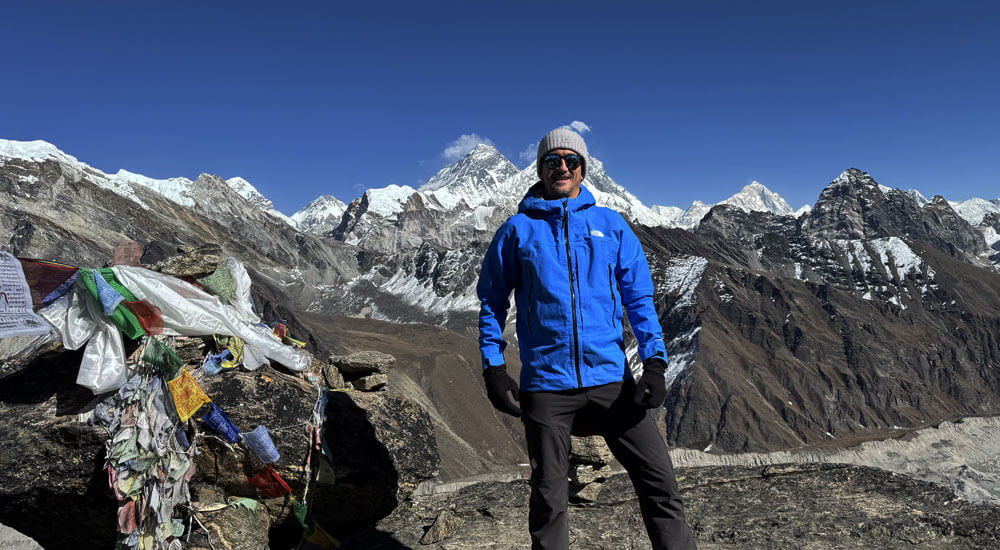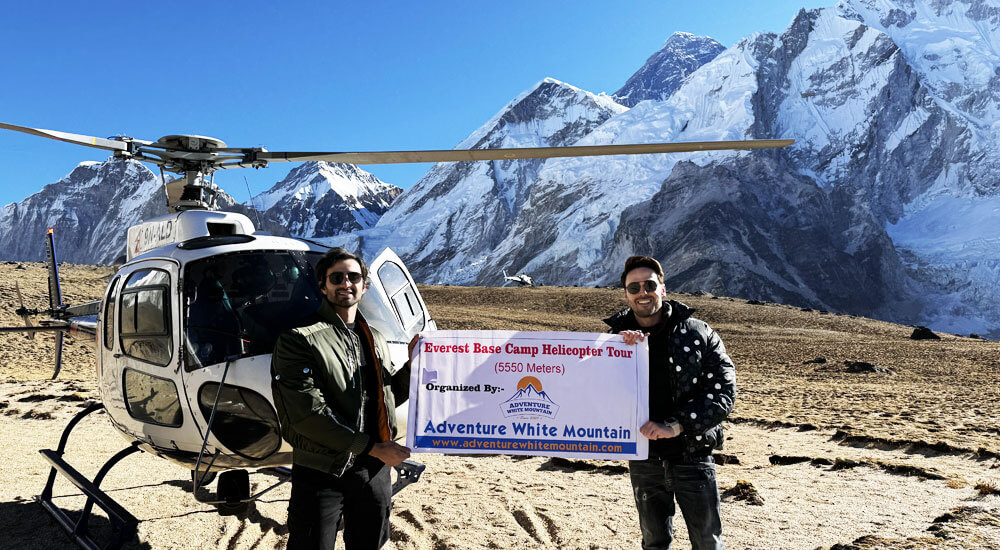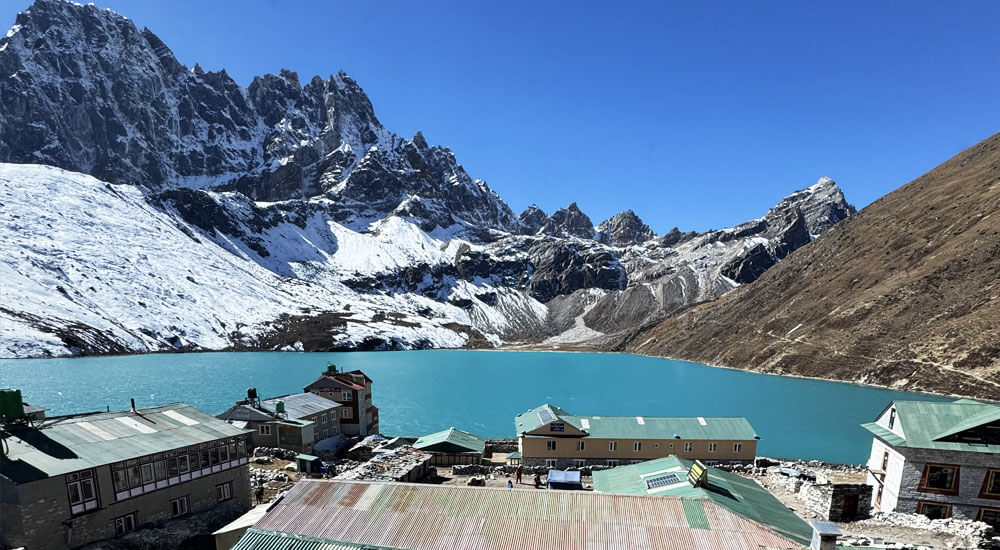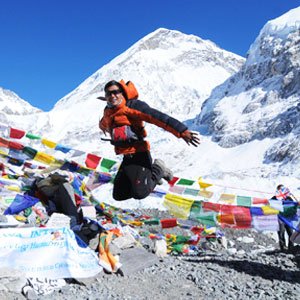What is it like trekking to Everest Base Camp?
Trekking to Everest Base Camp is adventurous, bold, emotional, and delightful. Setting your foot at the Everest Base Camp, the lap of Mount Everest, is the goal of this trek.
However, it is the journey that makes the Everest Base Camp trekking great and life-changing. It is one of the greatest treks humans can embark on in the Himalayan range.
This multi-day hike goes through beautiful Sherpa villages and lush rhododendron forests of Sagarmatha National Park in Nepal. You will ascend above the tree line and experience the alpine environment.
The trail involves varying altitudes from the start to the end of the trek. Therefore, you will experience and discover varying climates and vegetation. From lush valleys to glacier moraines and rocky peaks, the trip will be incredible.
You will reach Everest Base Camp in eight days of walking from Lukla and Kala Patthar in nine days of walking. Kala Patthar is the highest point during the Everest Base Camp trek.
It is a viewpoint and the final hike for trekkers who want to see Mount Everest closely. The trail is rugged and uneven, and you will continuously walk uphill and downhill.
The little interactions with the locals along the trail, the constant stunning mountain vistas and heavenly landscapes, and the hospitality of the local communities will enhance the trek, making it much more immersive and achievable.
You will enjoy the mountain lifestyle and get to know the local communities closely. On the way, visit ancient monasteries and explore stupas and Chortens. Life will be simple but very satisfying for the duration of the trek.
And mountains like Thamserku (6,608 m), Ama Dablam (6,812 m), Everest (8,849 m), Lhotse (8,516 m), Nuptse (7,861 m), Pumori (7,161 m), Cho Oyu (8,188 m), Makalu, Lobuche Peak, Chamlang (7,319 m), and many more will dot the horizon with their majestic presence.

What should you expect during the helicopter flight?
After hiking to Kala Patthar, you will descend back to Gorak Shep. You will catch the helicopter flight from Gorak Shep and fly back to Kathmandu. During the flight, fly over Khumbu Glacier and witness the aerial view of the trail you walked in the last few days.
Every passenger will get a full window seat to enjoy the views during the flight. The helicopter will be comfortable and spacious. Our pilot will quickly brief you on a few things for the flight.
One of our professional pilots will fly the helicopter, so you do not have to worry. After around 15 minutes of flying, you will reach Lukla Airport. We may need to refuel the chopper here.
From Lukla, you will fly back to Kathmandu, enjoying lovely scenery. The flight between Lukla and Kathmandu is 45 minutes.
Everest Base Camp trek with helicopter return itinerary
We have shared an 11-day Everest Base Camp trek with a helicopter return itinerary below. The itinerary is flexible, so you can customize it.
For instance, if you have time, add one full day in Kathmandu before flying to Lukla. Use this day to explore a few tourist sites and prepare for the trek.
Day 01: Welcome to Kathmandu and transfer to the hotel
Day 02: Fly from Kathmandu/Ramechhap to Lukla airport (2,846 m/9,337 ft) and trek to Phakding (2,610 m/8,563 ft) | 35 minutes flight & 3 hours trek
Day 03: Trek from Phakding to Namche Bazaar (3,440 m/11,290 ft) via Monjo (2,835 m/9,301 ft) | 6 hours
Day 04: Acclimatation day in Namche Bazaar. Hike to Everest View Hotel (3,962 m/13,000 ft) | 5 hours
Day 05: Trek from Namche Bazaar to Tengboche Monastery (3,860 m/12,660 ft) | 5-6 hours
Day 06: Trek from Tengboche to Dingboche (4,410 m/14,470 ft) | 6 hours
Day 07: Acclimatization day- hike to Nagarjuna Hill
Day 08: Trek from Dingboche to Lobuche (4,940 m/16,210 ft) via Dughla Pass (4,830 m/15,846 ft) | 6-7 hours
Day 09: Trek from Lobuche to Gorak Shep (5,164 m/16,942 ft) to Everest Base Camp (5,364 m/17,598 ft) and back to Gorak Shep for a night's stay | 8 hours
Day 10: Hike to Kala Patthar (5,545 m/18,129 ft) early in the morning and take a helicopter flight back to Kathmandu | 2-3 hours hike & 1.5 hours flight
Day 11: Final departure
Add-ons
Add-ons are extra activities and places that you can combine with your trek package. Note that extending your trek or combining additional activities will cost you money accordingly.
Extend the trek to Gokyo Lakes
- Extend the trek to Ama Dablam Base Camp
- Combine a high mountain pass in the itinerary
- Day hike around Kathmandu
- Chandragiri cable car ride
- A one-night retreat in Nagarkot
- Travel to Pokhara
- Jungle safari
- Cooking class
- Yoga/meditation class
- Aerial yoga class
- Sound bathing session
- Thangka painting class
- Street food tour
- Local shopping tour
- Rafting
- Bungee-jumping
- Zip-lining
- Paragliding
Is the Everest trek return by helicopter suitable for you?
Unlike the standard Everest Base Camp trek itinerary, which is usually 14, 15, or 16 days long, you can complete the same trek with a helicopter return in just 11 days.
A relatively shorter itinerary makes the EBC trek possible for travelers who are bound by time. The itinerary has two acclimatization days, so there is less risk of altitude sickness.
If you are planning to purchase trekking gear in Kathmandu, add one more day to the city before flying to Lukla. It will make your EBC Heli trek itinerary 12 days long.
Likewise, the Everest Base Camp trek with helicopter return is also suitable for trekkers who wish to skip the three days of return walking. Additionally, a helicopter flight will make your trek more special and give a grand ending to your voyage.
*Note: Travelers who are bound by time and couldn’t trek at all can choose our Everest Base Camp helicopter tour package. It also includes landing at Lukla and Hotel Everest View. You can complete this in just 4 to 5 hours. Another great option is Everest Experience Flight, which you can complete in just two hours. It is a commercial flight that is specially designed to provide you with a spectacular view of the eastern Himalayan mountains.

How do you handle the ECB trek challenges and cope with high altitude?
Trekking to Everest Base Camp is considered moderately challenging. Although you do not have to be an experienced trekker to do this trek, decent fitness and good health are necessary.
On average, you will walk six hours every day, which requires strength, stamina, and endurance. The trail involves walking through dense forests, crossing numerous suspension bridges, uneven cliff sides, rocky, steep tracks, and glacier moraines.
Likewise, the remoteness of the region limits the services along the trail. If you are not paying a premium price, you must adjust to basic lodges and limited services. Therefore, trekkers have to adjust a lot, so please prepare yourself mentally as well.
Additionally, as the EBC trek is a high-altitude trek, you also have to be aware of altitude sickness. Every day, you will gain approximately 500 meters and reach up to 5,545 meters above sea level.
The gain in altitude on this trek is huge, so acclimating is important to avoid altitude sickness. You can cope with high altitude by ascending slowly and maintaining your pace.
Similarly, keep yourself hydrated and have at least two acclimatization days in your itinerary. If you feel uneasiness or see symptoms of altitude sickness, inform your guide and get first aid.
How to prepare for the trek?
Everest Base Camp trek preparation may vary from person to person. Depending on your physical fitness, previous high altitude experience, and mental endurance, you have to prepare for the trek.
For instance, individuals who are not active in their daily lives and also have no previous trekking experience should start with regular long walks and gradually build their strength and stamina.
Book your trek early and have at least 4 to 6 weeks on hand to train yourself. During this duration, exercise, learn about the trek, and buy trekking necessities. Strength training, day hikes, aerobic exercises, and long walks are recommended.
Similarly, if you have previous trekking experience or are in good shape and confident, you can embark on the EBC trek right away. We take both advance and last-minute bookings for the Everest Base Camp trek with helicopter return.
Everest Base Camp trek with helicopter return cost
You can do the Everest Base Camp trek return by helicopter in a budget-friendly way or as a luxury lodge trek. We have shared details of both budget-friendly and luxury EBC trek return by helicopter below:
Budget Everest Base Camp trek with helicopter return cost
Our budget-friendly Everest Base Camp trek with helicopter return cost starts at USD 2,500 per person. We have a special price of USD 1950 per person for a group of five or more trekkers. Book your trek now to get the special price.
The budget-friendly package involves basic lodge accommodation along the way with permits, Lukla flight fare, three meals a day during trekking, porter, guide, helicopter flight, company's service charge, and accommodation and breakfasts in Kathmandu as per the itinerary.
Expenses like international flight fares to/from Kathmandu, Nepal travel visa fee, trekking clothes and gear, lunch and dinner in Kathmandu, bar bills, tips, travel insurance, shopping, etc., are not covered in the package price.
*Note: In basic lodges, you have to pay for services like charging, Wi-Fi, and hot showers. These are your personal expenses and are not covered by our package cost. Therefore, budget ample money to use during trekking.

Luxury Everest Base Camp trek with helicopter return cost
The luxury Everest Base Camp trek with helicopter return cost starts at USD 3999 per person and can go up to USD 4,500 per person. On the luxury trek, you will spend nights in premium lodges along the EBC trail.
These lodges offer very fine, chic, and contemporary accommodation. You will get a spacious room with excellent insulation and a private attached washroom. In the luxury lodge, you do not have to pay additional money for Wi-Fi, hot shower, and charging.
You will follow the same itinerary but spend the night in luxury lodges along the trail and fly back to Kathmandu in a helicopter from Gorakshep. Likewise, our luxury trek package includes a five-star hotel accommodation in Kathmandu.
Expenses like Nepal travel visa fee, travel insurance, international flight fares to/from Kathmandu, lunch and dinner in Kathmandu, bar bills, trekking clothes and gear, tips, shopping, etc, are not covered in the package price.
The best time to do the Everest Base Camp trek with a helicopter return
The best time to do the Everest Base Camp trek with helicopter return is spring (March to May) and autumn (September to November). Summer/monsoon (June to August) has unstable weather, frequent rainfall, and poor trail conditions.
Likewise, winter (December to February) is the coldest time of the year, with unstable weather and snow-covered trails. Trekking in the Himalayas is safe and incredible when the weather and climate are fine. Otherwise, the journey will become furthermore challenging because of weather hurdles.
Spring and autumn are the transitional times of the year. Therefore, the weather remains somewhat stable, and the climate mild. The trails are in great condition, and there is less risk of landslides. You will see clear mountain views and landscapes.
Likewise, during stable weather, both commercial Lukla flights and helicopter flights will be on time. There will be less chance of delays and the rare chance of flight cancellations. You will also enjoy the thrill of both flights to the fullest.
How about winter trekking?
Winter trekking to Everest Base Camp and helicopter return is possible with extra preparation and precautions. We encourage trekkers to try the EBC trek in the winter season because of the empty trails, tranquil environment, and low accommodation/food costs.
Because of weather unpredictability, winter is considered an off-time for trekking in the Himalayas. However, if you can tolerate cold weather and love snow, you will love the Himalayas in the winter season.
We highly suggest having 1-2 contingency days in your Everest Base Camp trek with a helicopter return itinerary in case the helicopter flight or Lukla flight gets delayed or canceled because of unfavorable weather.
Why is travel insurance necessary for Everest Base Camp trekking?
Foreigners have to compulsorily buy travel insurance that covers medical bills and helicopter evacuation to do the Everest Base Camp trek. All local Nepali trekking companies, including us, require well-covered insurance for the EBC trek to assure trekkers' safety.
We do our best to make the trek safe and comfortable for you. However, given the unpredictable nature of the Himalayas, rugged terrain, and high altitude, trekkers may get sick or hurt while trekking.
Though helicopter evacuation is not required for issues like this, it is better to have a backup. There is no hospital or major health post throughout the Everest Base Camp route.
Our trained guide will provide you with first aid and assess your condition for further medical assistance. We only use travel insurance if the situation demands an immediate airlift.
Trek packing list
Packing smartly is a necessary step for a hassle-free trek. You have to wear proper trekking clothes and use gear like trekking poles, sleeping bag, trekking shoes, etc.
Follow our below list to pack for the Everest Base Camp trek with helicopter return:
- Comfortable, light-weight underwear
- Trekking t-shirts and pants
- Base and thermal layers
- Windproof/waterproof jacket and pant
- Fleece jacket
- Down jacket
- Gloves, socks, scarf, beanie, sun hat, etc.
- Trekking boots and a casual pair of shoes/slippers
- Duffel bag and daypack
- Trekking pole, map, reusable water bottle
- Sleeping bag
- Toiletries (SPF, lip balm, toilet paper, wet tissues, moisturizer, toothpaste/toothbrush, soap, comb, etc.)
- Camera, adapter, charger, power bank
- Reusable water bottle
- Nuts, energy bars, snacks, etc.
- Camera, charger, mobile phone, adapter, etc.
- Small first aid kit, mini torch, and other essentials
.jpg)
Nepal travel visa
Travelers have to purchase a Nepali travel visa by themselves. It is not covered in the package cost. You can obtain a travel visa through the Nepalese Embassy in your country. Likewise, eligible countries can also apply for an on-arrival travel visa.
Citizens of Nigeria, Ghana, Zimbabwe, Swaziland, Cameroon, Somalia, Liberia, Ethiopia, Iraq, Palestine, Afghanistan, Syria, or a refugee with a travel document are not eligible for an on-arrival travel visa.
An on-arrival visa application is available online as well. Fill out the form and have the visa fee on hand for a quick process. We have shared the visa fee below:
- 15 days – 30 USD
- 30 days – 50 USD
- 90 days – 125 USD
Please check more about the Nepal travel visa here.
What permits are required for the Everest Base Camp trek?
To do the Everest Base Camp trek, you will need two permits: the Khumbu Pasang Lhamu Rural Municipality Entrance permit and the Sagarmatha National Park Entry permit. Trekking without these permits is considered illegal, and you will be fined accordingly.
There are many police check posts along the trail, so ensure you have your permits and other documents on hand. If you purchase the Everest Base Camp trek with a helicopter return package, the permit fees will be included in it.
- Khumbu Pasang Lhamu Rural Municipality Entrance permit cost: NPR 3000 per person
- Sagarmatha National Park Entry permit cost: NPR 3000 per person
Modern conveniences during the trek.
Wi-Fi: There is limited access to the internet or, we can say, the overall network in the Everest region. Lower altitude has a better network connection than the upper part of the region. Given the unique geography and unpredictable climate, the network mostly remains unstable. WiFi is available in selected villages at an additional cost of USD 2 to USD 3. For the EBC trek, we recommend buying an NCELL sim (Nepali sim) with ample data.
Charging: Charging also costs extra money. There are separate charging stations in lodges where trekkers are allowed to charge their devices. You can expect to pay USD 1 to USD 3 per device. Rooms have no charging socket. Due to limited electricity, it is a paid service. Spare batteries, power banks, or solar chargers are recommended.
Hot shower: Locals rely on gas, wood, and solar power to heat water for showers. Again, a hot shower is a privilege in the mountains and costs extra money. Each shower can cost you USD 4 to USD 7 as per altitude. Keep showering days low, and use wet wipes to keep yourself refreshed.
Private washroom: Basic lodges do not have private washrooms. Trekkers share washrooms. Toilets are usually made out of the lodge. Western-style toilets are found in many places, but you may have to use a squat toilet at the upper elevation. We will try our best to book your accommodation with Western-style toilets. Pack toilet paper, soap, hand sanitizer, etc.
.jpg)
Why should you do the Everest Base Camp trek with a helicopter return instead of a standard trek?
Everest Base Camp trek with helicopter return makes this world-class trekking expedition more adventurous and exciting.
Compared to the standard 14-day or 15-day EBC trek, the Everest Heli return trek costs more. But, the touch of helicopter flight allows you to experience mountains and valleys from the sky, which is nothing less than a privilege that only a handful of trekkers get to have.
And, of course, you will save time and can complete the trek sooner than the standard trek. Now, the standard Everest Base Camp trek is also great on its own.
You will spend more time in the mountains and obviously have more encounters with the locals and fellow trekkers. It really depends on what you are looking for in your Everest Base Camp trekking journey.






.jpg)
.jpg)

